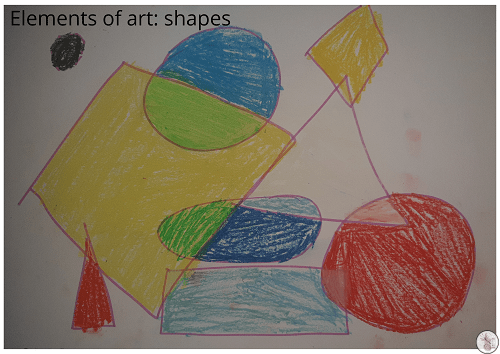We’ve been getting arty again, following on from the colour wheel we did the other day, and this time we’ve been looking at the second element of art – shapes. I had the kids draw the objects in the living room as shapes in a top-down view – they came up with a rectangular sofa, a square sofa, a rectangular bookshelf, a round fish tank. In the kitchen we had a square table, a rectangular cupboard a round food processor. We then imagined a fruit bowl and filled it with a crescent-shaped banana, a triangle-shaped pear, a number of round fruits… the aim was to show them how most art can be traced back to basic shapes: triangle, square, circle, rectangle, diamond and oval.
Organic vs basic shapes
Basic shapes are the ones we learn as kids. They are ordered, regular. When I say ‘circle’ you expect something round. Organic shapes are a bit different. They are irregular and imperfect and different from one another. They are often curved and free flowing. They are unpredictable. We watched this youtube video for some underpinning knowledge about shapes in art.

For the purpose of this exercise, we were focusing on basic shapes, but we also wanted to practice our last session’s colour mixing.
The project
For this one we used a sheet of card, a marker pen and oil pastels as per the instructions in the Redemptive Artistry free curriculum we’re following.

We started off the marker pen, drawing the basic shapes on our card paper. Make sure they overlap at times so that you can do the colour mixing, and we also found it easier to make larger shapes so the kids didn’t get bored mid-way through. We started off with just the three primary colours – red, yellow and blue – and coloured in the biggest three shapes.
We then did the surrounding ones that weren’t touching the main three colours, and finally filled in the intersecting colours with what we imagine a blend would look like – for example yellow intersects with white and dark blue? It’ll probably have a bit of lemon yellow and a dark green.

It was a good exercise in remembering the shadings (we did refer back to our colour wheel a few times, and also in understanding how basic shapes can initially be used to lay out an image – like how you might use a circle and an oval for a head and body, filling it out till you eventually have a picture of a dog.
The resulting pictures were pretty good too, and we’ve added them to our ever-growing art portfolios.
See also:
Elements of Art – Colour



